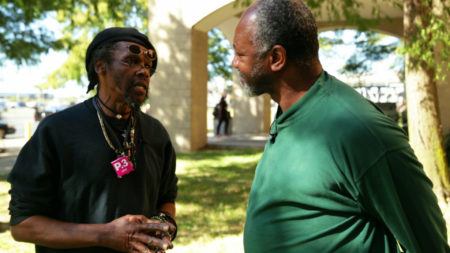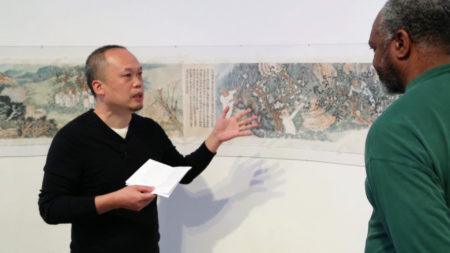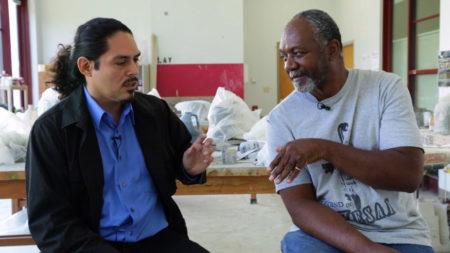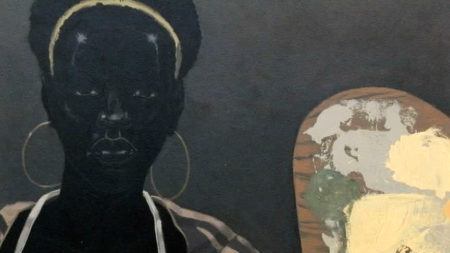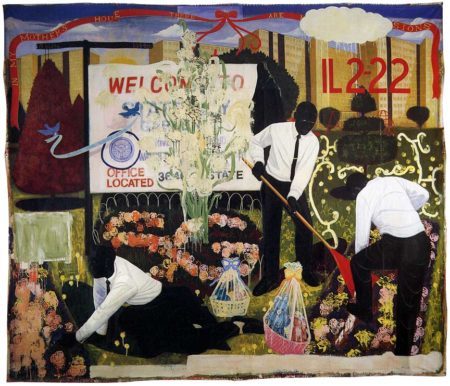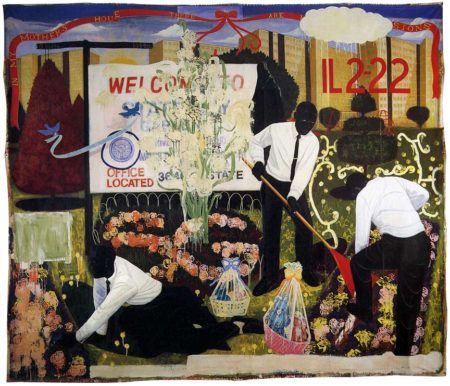Kerry James Marshall

Kerry James Marshall was born in 1955 in Birmingham, Alabama, and currently lives and works in Chicago, Illinois. The artist was educated at Otis Art Institute, where he received a BFA in 1978 and an honorary doctorate in 1999. In his work, Marshall interrogates Western art history, recontextualizing the canon to include themes and imagery that have been historically excluded. Through his paintings, drawings, installations, and public works, the artist builds a body of work that privileges the Black figure, using race, history, and everyday Black experiences as the inspiration for his work.
Born in Birmingham at the start of the American Civil Rights movement and later moving to Los Angeles just before the 1965 Watts riots, Marshall’s work is heavily influenced by his experiences and upbringing. “In his Souvenir series (1997-1998), the artist commemorates civil rights leaders and activists who fought for Black liberation in the United States. In Souvenir I and Souvenir II, the artist depicts the interior of a home with a winged Black figure performing household tasks, with the portraits of Rev. Dr. Martin Luther King Junior, President Robert F. Kennedy, and Senator Robert F. Kennedy hung on the wall with the text, “We Mourn Our Loss” beneath them. In Souvenir III and Souvenir IV, Marshall honors deceased writers, musicians artists, and other cultural producers whose works contributed to the civil rights movement and Black liberation, their names and faces floating in the foreground of both paintings. In Now and Forever (2023), a stained-glass commission for the National Cathedral, Marshall portrays figures peacefully protesting, looking to the history of protest and its role in the continual improvement of our country. Through these paintings and installations, the artist reflects on the racial and political history in the United States, memorializing and giving light to the stories and individuals that are otherwise left omitted.
In addition to highlighting historical and political figures, Marshall also uses his art to bring everyday Black life into the canon of art history through the language of Western art movemenets and tropes. In works such as Past Times series (1997), the artist places Black figures in the tradition of pastoral paintings. Likewise in School of Beauty, School of Culture (2012), Marshall draws upon the works of Velasquez, Holbein, and others to construct an image of contemporary Black life. “People like to make the kinds of things they like to make. You make things that are meaningful to you, but you also have to make things that are meaningful in some way to the discipline of making art itself,” Marshall says. In his painting Lost Boys (1995), the artist looks to police brutality and racial violence for inspiration. The work portrays a young Black figure killed by the police for holding a toy gun. He stands beside another figure who is playing on a coin-operated car, with police tape and wooden childhood boxes surrounding them. Through his work, Marshall injects the Western art historical canon with images that both celebrate Black life and point to/expose/remind us of the systemic violence and racism that Black Americans still face today.
Videos 12
-
Kerry James Marshall
Read
Galleries
“We only move into the 21st century on the foundation of things that have been established long, long ago.”
Kerry James Marshall


